Modern Mailbag
It's Modern Week and as I don't have a lot of design for the format, I thought I'd use this column as an opportunity to do a mailbag column. Here's the tweet I posted:
I'm working on a mailbag column and I need your help. Please send me a design question about any card or mechanic in Modern. Thanks.
— Mark Rosewater (@maro254) April 24, 2015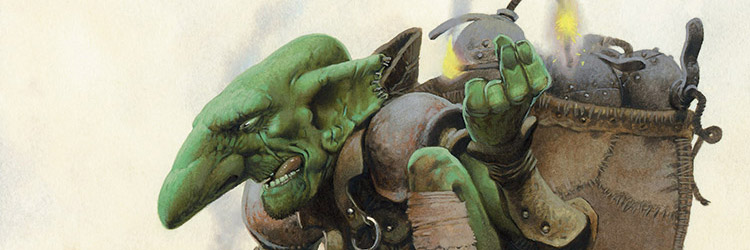
Goblin Kaboomist | Art by Kev Walker
I got a lot of responses but only a single column to respond, so a few caveats before I start answering questions. I received way more questions than I can answer so please be aware that not every question sent to me will be answered. I will also note that I got a lot of developer questions that I felt unqualified to answer. That said, on with the questions:
@maro254 Was Path to Exile originally planned for Zendikar? Triggering Iandfall seems like it could've been a nice drawback for limited.
— Dave Smith (@mowdownjoe) April 24, 2015No, Path to Exile was originally created during Conflux design. Another telltale sign that it didn't originate in Zendikar is I'm personally not a huge fan of these style of white removal cards. I prefer white's answers having answers (à la Pacifism or Oblivion Ring) or white having some built-in rules it follows ("We'll respond, but we don't start fights.") that create some restrictions to build around. White is allowed to "trade" by giving the creature's controller something of value. But these cards, when we're not careful, tend to edge out black as the most versatile creature kill cards—an ability that I firmly believe is supposed to be in Black. These cards are usually made by development because they are important for balancing Standard.
@maro254 Why does Viscerid Deepwalker have firebreathing? Are Homarids just so smart that they broke the color pie before Planar Chaos?
— Andrew Weisel (@_SEV8) April 24, 2015Blue doesn't power pump often (aka "firebreathing"), but it is something that blue is allowed to do within color pie. In fact, power and/or toughness pumping is something so basic that all five colors have some access to it, certain colors more than others.
@maro254 if you could change the design of Stoneforge Mystic to mean she wasn't banned, what would you change?
— Alex Balhatchet (@kaokun) April 24, 2015The key is to not let her both tutor for Equipment and circumvent their mana cost. Pick one or the other and she'd be much more fair.
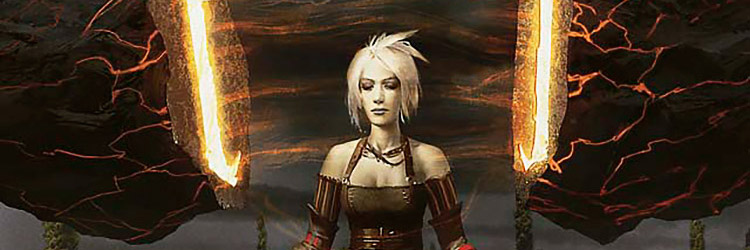
Stoneforge Mystic | Art by Mike Bierek
@maro254 Did Alara have an abortive "artifacts in graveyards" mechanic? Windwright Mage and Salvage Slasher reference them.
— Nice_Ekhat (@Nice_Ekhat) April 24, 2015I was the lead designer for the Esper mini-team, so I can answer this with a definitive "No." What was going on was that we wanted a lot of different ways to make artifacts matter. To help create variety and increase the different kinds of Esper decks you could draft and build, we mixed up the types of "artifact matters" card designs.
@maro254 What design space does Mirror Entity occupy. Does white get more cards like it, or has it shifted out of white?
— Daniel Hoffman (@djhoffma) April 24, 2015This is space we've messed around in a few times, changing all your creatures to a particular size, sometimes also copying abilities. White gets "make everyone the same" and blue gets the "polymorphing others" flavor so this ability is mostly seen in white and/or blue. Will we do more of this? Probably, but it's something I'd expect to be used infrequently.
@maro254 Can we ever PLAINSwalk again? Pretty please?
— gabriolo (@dosanjosgabriel) April 24, 2015The real question is can we ever LANDwalk again? Landwalk has really fallen out of favor with R&D and thus is not getting used very often. More on this in a couple of weeks. Even if we were more actively using landwalk, plainswalk has always been the least used basic landwalk type because it's not a great fit for its color mechanically nor has particularly strong flavor. Also, the fact that "planeswalk" is an important concept in the game makes us even less want to put "plainswalk" in rules text.
@maro254 In retrospect, how do you guys feel about Phyrexian Mana?
— Cure Space Marine (@NetbrianT) April 24, 2015When Aaron Forsythe and I first came up with the mechanic, I stressed that I thought it should stick to effects that artifacts can normally do. The goal of Phyrexian mana was to color bend not color break. As such, I was unhappy with a few cards that ended up getting printed. The mechanic was popular so if we see the Phyrexians again (and that's more than likely), there's a chance Phyrexian mana could return. If it did, we would work hard to be more careful with what effects we use it on.
@maro254 why werent split second cards designed to respond to each other?
— Kenyon Colloran (@Azcz) April 24, 2015Because time has shown us that having mechanics be as simple as they can tends to lead to better designs.
@maro254 Any chance we'll ever see suspend again? I almost thought it might appear in Tarkir with the time theme... :)
— Abusive yoda (@abusiveyoda) April 24, 2015I had high hopes, when we created suspend back in Time Spiral, but the required templating and the counter manipulation just confused too many players, leading to a very lukewarm response from the majority of players. It's possible a simpler, cleaner version might be found one day but I'm skeptical suspend, as-is, would come back to a Standard-legal set. A non-Standard legal set? There's a slightly better chance.
@maro254 Are you wary of designing cards like Birthing Pod, which improve as more cards enter the Modern format?
— Michael M. (@Firbozz) April 24, 2015Design designs cool cards which we think players will enjoy using. Preemptively banning areas of design because larger formats might have issues is not how we do things. If the larger formats have problems, they can ban the card. As long as there are smaller environments (Standard and Limited, especially) where we think the card will shine and be beloved, we'll make it.
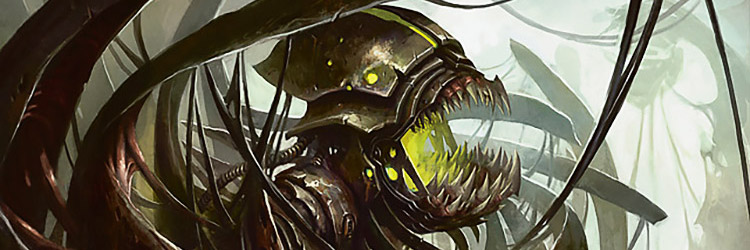
Birthing Pod | Art by Daarken
@maro254 Fateseal. Seen on a couple of cards both as a mechanic and as a planeswalker ability. How did the design come about? Liked by R&D?
— Normality (@Normality) April 24, 2015As the designer of the mechanic, I can tell you exactly where it came from. It was created to be negative scry. In fact, in design I think it was called "Evil Scry." It proved to be a very un-fun mechanic, so I would not be expecting the keyword mechanic showing up again any time soon. That doesn't mean though it couldn't show up on a single card as a non-keyword.
@maro254 Do you feel Haunt would have been more successful if the creature had become an aura upon dying similar to bestow?
— QuarterNote (@QuarterNote_) April 24, 2015Haunt, in its current incarnation, baffled a lot of players…so some change would be welcome. There are some wordiness issues with your suggestion, and it could only go on permanents, but the flavor's pretty cool.
@maro254 Will the r&d take action on riggers and contraptions anytime soon in modern? The archetype is clearly out of hand.
— Chris Preston (@emperorkursan) April 24, 2015I don't know my boss really likes that deck. And by my boss, I mean my Steamflogger Boss. : )
@maro254 If you had to pick one mechanic from Coldsnap to use in the next block what would it be?
— GaddockTeeg (@GTeeg) April 24, 2015If you're asking which mechanic thematically makes the most sense in Battle for Zendikar, I'd say "recover." If you're asking which mechanic I would choose if I had to use one and was building a block from scratch, I'd say snow mana (yeah, it's more of a tool than a mechanic but there aren't many to choose from).
@maro254 Have you ever considered making new cards that would only be legal in Modern (or Eternal)? e.g., Containment Priest seems fine.
— Chris Ingersoll (@Vyolynce) April 24, 2015It's definitely an idea that gets suggested a lot by the fans, and as such we've talked a bit about it. For now, though, we're sticking with making the entrance to Modern things that first go through Standard.
@maro254 What was the thought behind Vedalken Shackles? Was it a perceived need that Blue had at the time?
— Erin Campbell (@OriginalOestrus) April 24, 2015Vedalken Shackles was created by Aaron Forsythe as a cool artifact for blue to play. We don't often make artifacts that can only function in one color, but we felt Vedalken Shackles was cool enough to make an exception. I believe the design was more a cool one-of design and less something Aaron felt was needed in the Standard environment.
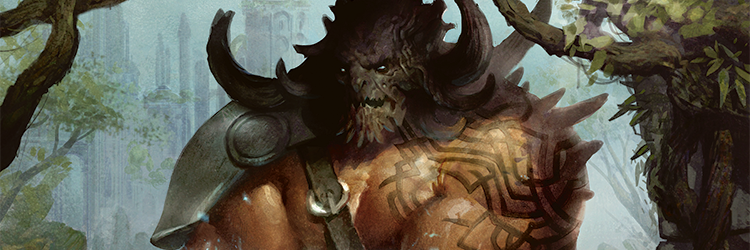
Vedalken Shackles | Art by Svetlin Velinov
@maro254 Did you ever consider just going back to morph in #DTK - are you happy with how Megamorph plays by comparison?
— Magic Chat (@MagicChatTeam) April 24, 2015It was important that morph in the third set had some change to reflect the change of the overall world. I think megamorph plays well, but if I had to do it again I would do it a little differently. More on this in this year's State of Design column coming this August. Also, knowing what I know now, I would have changed the name. I would not have, however, just used "morph."
@maro254 Did Trap Essence ever counter all spells, or was that considered to be too powerful or a flavor miss?
— TILDE SATAN (@Mightfo) April 24, 2015The card was designed as-is. There's a design aesthetic at work here—both sides interact with creatures, one negatively and the other positively.
@maro254 Was Sanguine Praetor from Guildpact originally to be a cycle like the Primordials from Gatecrash?
— Thomas Robertson (@AqueousDoubt) April 24, 2015I was not on that design team, but to the best of my knowledge, no.
@maro254 phyrexian mana! If it shows up in the future, will it use the phyrexian logo?
— Oros (@kibas_paradise) April 24, 2015If it's called Phyrexian mana, it will. Could we remake the mechanic with a new name and graphic treatment? Possibly.
@maro254 Which of the hinted at mechanics from Future Sight that have not already made their "real" debut do you think still have a chance?
— Don Wiggins (@TheSundry) April 24, 2015I'll stick all the futureshifted mechanics/card-types into one of four categories:
Did It:
Chroma/Devotion (unnamed in Future Sight)
Deathtouch
Delve
Lifelink
Planeswalker
Reach
Shroud
Tribal (the card type)
There's a Chance We'll Do It:
Fortify
Grandeur
There's a Tiny Chance We'll Do It:
Absorb
Frenzy
Poisonous
[Card type] Swap
[Type]cycling
I'm Very Skeptical We'll Ever Do It:
Fateseal
Gravestorm
Transfigure
@maro254 what style of play do you think a deck winning with poison counters should employ?
— Simon Baldwin (@lhsi) April 24, 2015Poison was crafted in Scars of Mirrodin block, so there was both a quick and slow way to play with it. The first tends to be a one-color agro deck with some form of power pumping. The other is more controlling, usually making use of proliferate.
@maro254 What was the thought process behind scapeshift? Was a potential combo deck something you saw coming?
— William Wadbrant (@LunaeaDomia) April 24, 2015I believe the card was designed partly as a deck-thinner and partly as a way to adjust your colors of mana. It was clearly made open-ended to allow combo potential. But that wasn't, to the best of my knowledge, the driving force behind its design.
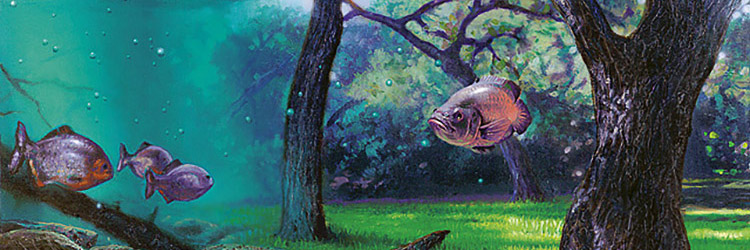
Scapeshift | Art by Fred Fields
@maro254 What is the thinking behind repeating a mechanic with a slight tweak like Fading -> Vanishing. Neve understood
— Kurt (@MrEasyStreet) April 24, 2015We think of mechanics as resources to be used again and again throughout what we plan to be Magic's lengthy history. If we believe a mechanic was built incorrectly the first time, we will fix it so we get the mechanic we want, which can then be used in the future. Fading's mistake was too many players thought the card went away when you removed the last counter, not when you couldn't remove a counter. Vanishing was just the fixed version that functioned the way the majority of players believed it was supposed to work.
@maro254 What, if anything, is the difference between Chroma and Devotion? Was the name just changed for flavor?
— CJ Mlsna (@themlsna) April 24, 2015The change is a subtle but important one. Chroma counts the appropriate mana in the mana cost on any card in whatever zone the card tells you to look. Devotion only looks at permanents on the battlefield. Almost all chroma cards worked that way anyway, and it allowed us to put the text in the reminder text (making the mechanic feel less word-heavy). While fixing this mechanical issue, we also fixed the name to help reinforce the flavor of the mechanic.
@maro254 How/why was Amulet of Vigor made? The same for Azusa, Lost but Seeking?
— Brendan Perrotta (@Blndbat8719) April 24, 2015Amulet of Vigor was made to undo the handicap of cards that enter the battlefield tapped. Azusa, Lost but Seeking was made to help you get land onto the battlefield faster to cast giant spells.
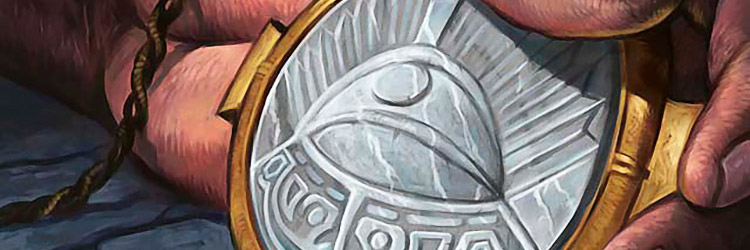
Amulet of Vigor | Art by Warren Mahy
@maro254 is the design problem with Stoneforge Mystic the equipment cards printed in SoM?
— J. Matheo Gavilano (@vagabundomg) April 24, 2015No, the problem was making a card that circumvented both the drawing and mana cost of one of the major themes of the following year's block.
@maro254 What color is Blood-Chin Rager's evasion ability? Generally red, not black - I think. Is this bleed or a new direction?
— Dan Nelson (@DanRLN) April 24, 2015This is an ability ("can't be blocked except by two or more creatures") R&D refers to as the "Goblin War Drums" ability. We've used it in red for years and experimented in Dragons of Tarkir with also using it in black.
@maro254 can devotion design space allow for other things than mana symbols? Ie. Enchantments
— Bruce Davis (@reginaldwarwick) April 24, 2015No, devotion can only count mana symbols.
@maro254 Why are there no partly-Phyrexian mana costs (some colored mana, some P mana)?
— stillnotelf (@stillnotelf) April 24, 2015It makes it both slightly harder to parse and prevents part of the cool aspect of Phyrexian mana, the ability to splash it in a deck of a different color.
@maro254 How did Doran, the Siege Tower come about? Was it top-down or bottom-up?
— Eric Wong (@sequentialsmart) April 24, 2015To the best of my knowledge, it was a top-down design trying to make a mechanic that felt very treefolk-y.
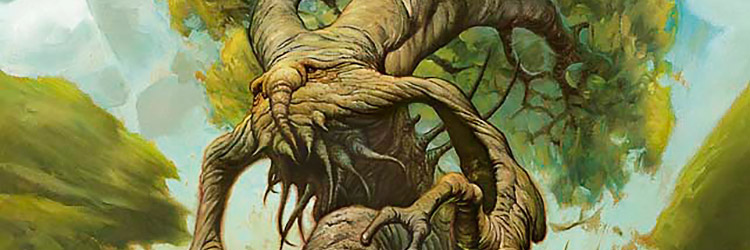
Doran, the Siege Tower | Art by Mark Zug
@maro254 was there a reason you decided to make Keranos trigger on a nonland card instead of instant/sorcery as is typical of an izzet card?
— Brandon Susens (@Purdy_Nerdy) April 24, 2015This is another example of design aesthetic at play. One ability triggers on land cards, so the other is the opposite, it triggers on nonland cards. This way every card triggers something.
@maro254 what kind of questions, like "did you have undying in mind when you were creating persist?"
— Janeburger® Grunt (@DaZodiac) April 24, 2015Persist was created by a designer named Nate Heiss (in Lorwyn design, interestingly, when we were toying with -1/-1 counters as a way to be less lethal than out and out killing) because he was trying to find cool ways to use -1/-1 counters. Undying, however, was very much influenced by persist. I had been tasked with coming up with a cool monster mechanic for Dark Ascension. I was bouncing ideas off my wife when she asked if there was an existing mechanic that did what I wanted. I said yes. It was called persist. She asked me why I didn't just use that. I said I couldn't because the set had +1/+1 counters and not -1/-1 counters and—boom—I realized what I had to do.
@maro254 exalted is a fun mechanic, what are the chances of us seeing it in standard soon?
— Anderson LeClair (@leclairandy1231) April 24, 2015The fact that we were willing to bring it back to a core set means it's something we feel is fun and accessible. That means the chance of its return is high.
@maro254 Are cards specifically designed for modern? If so how do you design cards strong enough for modern but not enough to warp standard?
— Michael Reiss (@Shanktastik) April 24, 2015Design doesn't tend to design cards specifically for a format, as we don't even set the power level. Development's focus is mainly on Standard and Draft, but they do occasionally make cards with Modern in mind.
@maro254 Can you tell any stories about the card Mercy Killing and how sacrifice-based removal wound up in G & W?
— Triumph (@Historian327) April 24, 2015In design, the card was thought of less as removal and more as changing the creature from one big creature into a bunch of little creatures. This ability was put in green-white because there are times you'll want to turn your big creature into lots of little creatures due to the natural ability of green-white to boost your entire team.
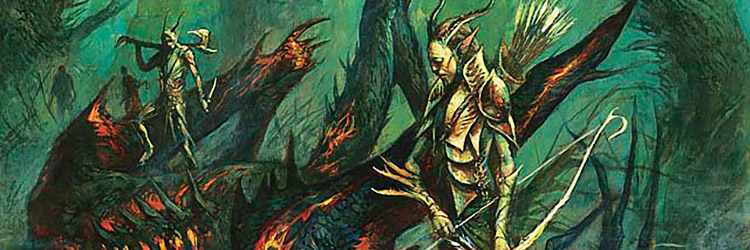
Mercy Killing | Art by Dave Kendall
@maro254 Are you a fan of narrow SB hosers like Stony Silence or are they a necessary evil that you would prefer not be needed?
— Riki Hayashi (@mtgRikipedia) April 24, 2015I'm a fan as long as they are narrow enough. I think Magic works best when there are niche sideboard answers.
@maro254 Why aren't Scry, Cycling and Tribal evergreen?
— Tom Strong (@MtgTom24) April 24, 2015There are a limited number of keyword abilities (and keyword actions) that get to be evergreen. If we wanted to make one or more of those abilities evergreen, we'd have to remove one or more existing evergreen keywords to make space. Note that "tribal" is a card type, not a mechanic, that we have since abandoned making new cards with (but is still supported on old cards).
@maro254 When equipment were created, did you think the card type would still have a huge influence on the game a decade later?
— Mike Cannon (@MTGCannon) April 24, 2015When we were designing Equipment in Mirrodin, we were aware we were playing around with something pretty universal. Equipment, essentially, got printed and became evergreen almost immediately, never going away.
@maro254 Were the Titans always supposed to be giants? I'm sad that Grave Titan isn't a zombie :(
— John de Jong (@momomoto) April 25, 2015I believe even in their earliest version, the Titans were always Giants.
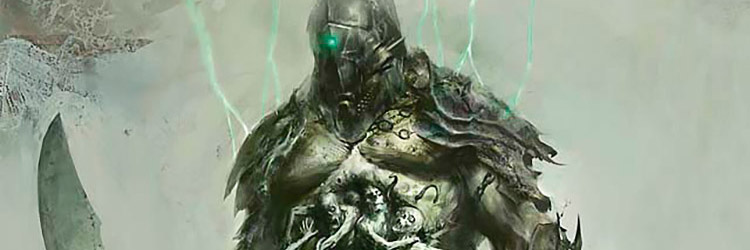
Grave Titan | Art by Nils Hamm
Post-Modern
Whew. That was a lot of questions. I want to thank everyone who took time to send them in. As always, I'm eager for any feedback you have on today's column. You can email me or send me feedback through any of my social media (Twitter, Tumblr, Google+, and Instagram).
Join me next week, when I take you around the world.
Until then, may you play much Modern and come up with even more questions.
"Drive to Work #226—10 Things Every Game Needs—Inertia"
This is the fifth in my 10-part series "10 Things Every Game Needs." In this podcast, I talk about why a game needs inertia.
"Drive to Work #227—2009"
This is another in my podcast series "20 Years in 20 Podcasts." Today I talk 2009, a very busy year for Magic.
- Episode 227 2009 (14.6 MB)
- Episode 226 Inertia (18.2 MB)
- Episode 225 White-Black (15.5 MB)
- Episode 224 Origin Story (19.0 MB)
- Episode 223 10 Principles (14.2 MB)
- Complete Drive To Work Podcast Archive

